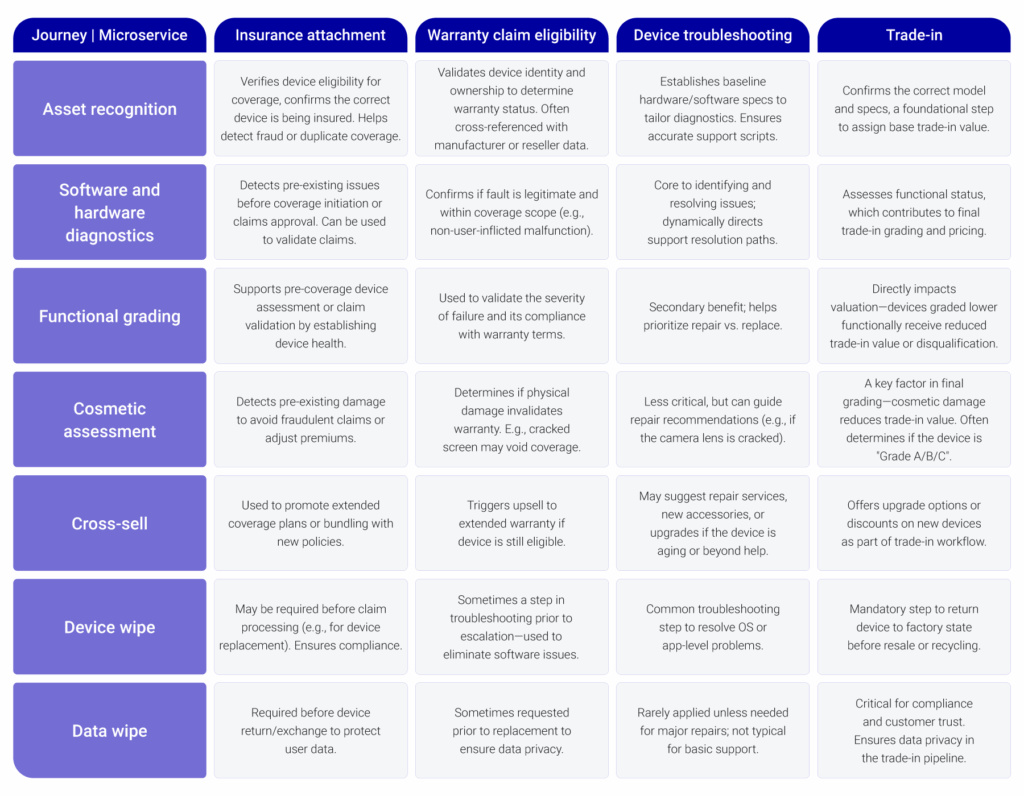Operators have invested in billing and network enhancements toward addressing customer lifetime levers (CLV) levers – cost of service, customer retention and monetization of interactions. The last bastion, however, left where CLV impact can be felt most is in managing customer mobile device-related experiences. Because of the multi-faceted and fragile nature of the mobile device lifecycle – from onboarding to in-life to retention – it’s important to have the right technology, your bricks, within each step and take a holistic, platform approach.
The Four Mobile Device Journeys That Matter Most to CLV
When it comes to customer journeys involving mobile devices, the paths can seem complex. But from a business value perspective—especially in terms of Customer Lifetime Value (CLV). These can be distilled into four critical journeys:

These journeys don’t always exist in isolation. In fact, they often intersect. A device issue reported during a troubleshooting session, for example, may lead to a trade-in offer – especially if the customer is nearing the end of their typical ownership cycle (around two-and-a-half to three years).
However, each journey comes with its own friction points, which are moments where an operator might face financial risk or customer experience degradation. To address this, operators must optimize around three fundamental areas:
- Issue Resolution – Can we identify and solve the problem efficiently?
- Objective Evaluation – Can we assess the device accurately and fairly?
- Omnichannel Connectivity – Can we carry context and actions across digital and physical channels so customers don’t lose traction in their journeys?
Let’s break down how these challenges play out in each journey:
Insurance Attachment: Without the ability to assess the device’s software state and cosmetic condition, operators may either reject viable customers or take on too much financial exposure. This also limits their ability to proactively identify high-potential customers during the device lifecycle.
Warranty Claim Eligibility: When diagnosis capabilities are lacking, it becomes difficult to distinguish between a legitimate manufacturing defect and customer misuse. The result? A surge in No Fault Found claims—costly for operators and OEMs alike.
Device Care: Many operators struggle to accurately triage device issues, leaving customers without clear resolutions—whether that’s advice, a repair path, or a trade-in offer. Worse, when customers move between channels (e.g., app to retail), the lack of data continuity means they must start over, hurting satisfaction.
Trade-In: Objective device assessment is essential to offering fair and consistent valuations. But without a common data layer, any transition from digital to physical channels forces customers to repeat steps, leading to frustration and drop-off.
These four journeys are high-impact levers for CLV, but only if operators have the tools and integration needed to resolve issues accurately, evaluate devices objectively, and seamlessly connect channels.
A holistic, technical platform approach with multiple technologies
To fully unlock the value of mobile device journeys—whether it’s insurance, warranty, care, or trade-in—operators need more than isolated tools. They need a platform approach.
A platform delivers a holistic, process-oriented, and technology-driven foundation for managing device interactions across every touchpoint. It breaks down channel silos, ensures consistency across journeys, and maintains service continuity as customers move between digital and physical environments.
Think of the platform as a brick builder: for each customer journey, specific technology “bricks” are applied to ensure the operator can deliver accurate outcomes, reduce risk, and improve experience. At the heart of this approach are technologies that function like microservices—modular capabilities that generate real-time device intelligence and power more effective, connected journeys. Here’s what they do:
- Asset Recognition: Captures device identifiers like IMEI or serial number to confirm ownership, detect fraud, and accurately determine the device’s make, model, and configuration.
- Software and Hardware Diagnostics: Runs automated tests on core components and systems to assess overall device health and guide support or eligibility outcomes.
- Functional Grading: Categorizes the device based on diagnostic performance—fully functional, partial fault, or non-functional—to support fair trade-in pricing, warranty validation, or insurance qualification.
- Cosmetic Assessment: Evaluates external wear and damage (e.g., scratches, cracks) using AI imaging or manual review to determine eligibility and impact pricing.
- Cross-Sell: Suggests relevant offers such as upgrades, extended protection, or accessories based on real-time device status and behavioral context.
- Data Wipe: Ensures secure, compliant deletion of all personal data prior to device handoff—critical for privacy and resale readiness.
Each microservice technology plays a key role in de-risking business processes, enabling operators to make informed decisions and deliver smoother customer experiences. And when connected by a platform-wide data layer, they allow for intelligent handoffs between channels—ensuring that no customer has to repeat steps, no matter how their journey unfolds.
The effect of the microservices and connecting it all together
Each individual microservice can have its own siloed impact on a customer journey. But we can see collectively the impact of several microservices on each journey.

One of the most powerful benefits of a platform-based approach is the ability to layer in omnichannel intelligence. This means that all device-related data—collected through microservices like diagnostics, grading, and asset recognition – can be seamlessly transferred across channels. The result is a frictionless experience for the customer and operational efficiency for the operator.
Take the trade-in journey as an example. A customer may begin the process in the app and complete it in a retail location. Without omnichannel connectivity, that customer would likely need to restart the process in-store—repeating diagnostics, assessments, and paperwork. But with a unified platform in place, everything flows together.
In fact, operators that use an omnichannel platform to connect remote and in-store workflows have seen retail trade-in processing times cut by 78 percent, according to internal MCE data.
Here’s what that looks like in practice, with customer Jeff as our example:

MCE’s digital device lifecycle management (dDLM) platform allows mobile operators to pick and choose the microservices they need for each customer journey to ensure full business process and regulatory compliance. The dDLM platform’s common data layer ensures cohesiveness between microservices and connectivity between channels to ensure customers have a fluid experience, no matter which channel they choose to interact with their operator. Learn more about the platform, how we impact customer experiences, like Jeff’s, and the economic impact of the microservice technologies collectively here.




